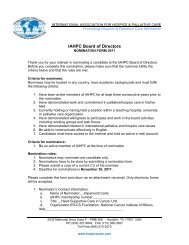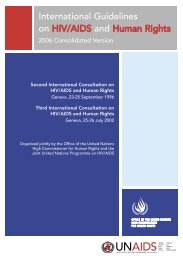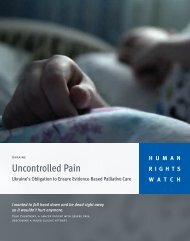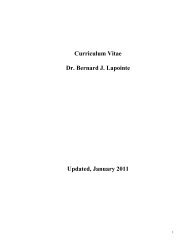INTERIGHTS Bulletin
INTERIGHTS Bulletin
INTERIGHTS Bulletin
Create successful ePaper yourself
Turn your PDF publications into a flip-book with our unique Google optimized e-Paper software.
160<br />
<strong>INTERIGHTS</strong> <strong>Bulletin</strong><br />
Volume 16 Number 4 2011<br />
Torture and Ill-Treatment in<br />
Health Settings: A Failure of<br />
Accountability<br />
Campaign to Stop Torture<br />
in Health Care<br />
The absolute prohibition under human<br />
rights law of all forms of torture and<br />
cruel, inhuman and degrading<br />
treatment (‘torture and ill-treatment’)<br />
does not apply only to prisons, pre-trial<br />
detention centres and other places<br />
where torture and ill-treatment are<br />
commonly thought to occur. It also<br />
applies to places such as schools,<br />
hospitals, orphanages and social care<br />
institutions – places where coercion,<br />
power dynamics and practices<br />
occurring outside the purview of law or<br />
justice systems can contribute to the<br />
infliction of unjustified and severe<br />
pain and suffering on marginalised<br />
people.<br />
This article focuses on torture and illtreatment<br />
in health settings, including<br />
hospitals, clinics, hospices, people’s<br />
homes or anywhere health care is<br />
delivered. It does not seek to stigmatise<br />
health providers as ‘torturers,’ but<br />
rather to focus on government<br />
accountability for placing health<br />
providers and patients in unacceptable<br />
situations whereby torture and illtreatment<br />
is neither documented,<br />
prevented, punished, nor redressed.<br />
The United Nations Human Rights<br />
Committee has explicitly recognised<br />
that the legal prohibition against<br />
torture and ill-treatment protects ‘in<br />
particular...patients in...medical<br />
institutions.’ 1 Yet, national, regional<br />
and international mechanisms to<br />
promote accountability for and to<br />
prevent torture are rarely applied to<br />
health settings. Human rights bodies<br />
responsible for monitoring<br />
compliance with anti-torture<br />
provisions should systematically<br />
examine health settings in their<br />
reports and make actionable<br />
recommendations to governments on<br />
how to stop this abuse.<br />
The Legal Definition of Torture and Ill-<br />
Treatment<br />
The legal definition of torture and illtreatment<br />
is broad enough to<br />
encompass a range of abuses<br />
occurring in health settings. Under<br />
international law, any infliction of<br />
severe pain and suffering by a state<br />
actor or with state instigation, consent<br />
or acquiescence can, depending on the<br />
circumstances, constitute either<br />
torture or ill-treatment. 2<br />
Whether an act qualifies as ‘torture,’<br />
‘cruel and inhuman treatment or<br />
punishment,’ or ‘degrading treatment<br />
or punishment’ depends on several<br />
factors, including the severity of pain<br />
or suffering inflicted, the type of pain<br />
and suffering inflicted (i.e. physical or<br />
mental), whether the pain and<br />
suffering was inflicted intentionally<br />
and for an improper purpose, and<br />
whether the pain and suffering is<br />
incidental to lawful sanctions.<br />
Generally speaking, cruel and<br />
inhuman treatment or punishment<br />
can be intentional or unintentional and<br />
with or without a specific purpose,<br />
while torture is always intentional and<br />
with a specific purpose. 3<br />
Examples of Torture and Ill-Treatment<br />
in Health Settings<br />
Torture and ill-treatment in health<br />
settings commonly occur among<br />
socially marginalised populations.<br />
People who are perceived as ‘deviant’<br />
by authorities, who pose a ‘nuisance’ to<br />
health providers, who lack the power to<br />
complain or assert their rights or who<br />
are associated with stigmatised or<br />
criminalised behaviours may be<br />
especially at risk. The following are<br />
selected documented examples of<br />
torture and ill-treatment against<br />
specific populations.<br />
People needing pain relief, whether as<br />
part of palliative care or for chronic<br />
disease, injury, surgery or labour may<br />
experience ill-treatment if their pain is<br />
severe enough and avoidable. Denial of<br />
pain relief is a pervasive problem<br />
among all of the populations discussed<br />
below: people with disabilities, women<br />
seeking reproductive health care,<br />
people living with HIV, people with<br />
tuberculosis, people who use drugs,<br />
sex workers, lesbian, gay, bisexual,<br />
transgender and intersex (LGBTI)<br />
persons, and Roma. Denial of pain<br />
relief is also disturbingly common<br />
among children. According to the<br />
World Health Organization,<br />
approximately 80 per cent of the<br />
world’s population – or tens of millions<br />
of people each year – have either no or<br />
insufficient access to treatment for<br />
moderate to severe pain, leading to<br />
profound physical, psychological and<br />
social consequences. 4<br />
In interviews with Human Rights<br />
Watch, people who had experienced<br />
severe pain in India ‘expressed the<br />
exact same sentiment as torture<br />
survivors: all they wanted was for the<br />
pain to stop. Unable to sign a<br />
confession to make that happen,<br />
several people [said] that they had<br />
wanted to commit suicide to end the<br />
pain, prayed to be taken away, or told<br />
doctors or relatives that they wanted to<br />
die.’ 5<br />
A 28-year-old former drug user from<br />
Kyrgyzstan reported in 2006 that he<br />
had been given orthopaedic surgery<br />
without anaesthesia because doctors<br />
feared it would fuel his addiction.<br />
‘They tied me down,’ he said. ‘One<br />
doctor held me down, pushed me to<br />
the table, and the second doctor gave<br />
the operation. I was screaming, awake,<br />
feeling all the pain, screaming and<br />
screaming as they hammered the nails<br />
into my bones.’ 6<br />
The reasons for denial of pain relief are
















